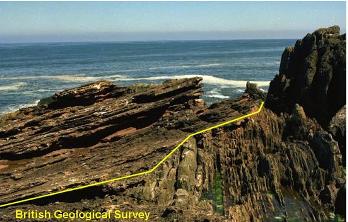Lifting Up and Wearing Down
Lifting Up and Wearing Down – The Time Factor:
 When Hutton (see “Key Ideas”)) wrote his “Theory of the Earth” around 1750, he had no idea of the time needed for geological processes like weathering, erosion, burial or uplift. He did reason, however, that since he could not directly observe these processes in action, they must be very slow.
When Hutton (see “Key Ideas”)) wrote his “Theory of the Earth” around 1750, he had no idea of the time needed for geological processes like weathering, erosion, burial or uplift. He did reason, however, that since he could not directly observe these processes in action, they must be very slow.Hutton was fascinated by the rocks at Siccar Point in Scotland (above left). He realised that the rock layers beneath the line on the picture must have once been laid down as horizontal layers of sediment. Later on, they must have been folded and uplifted, and then undergone a period of erosion that planed off the layers. Later still, new layers of sediment (those above the line) were laid down on top. Finally these, too, must have been uplifted and tilted before another period of erosion exposed them as they are now. How long must all this have taken?
Until the late 20th century, no one knew how long geological processes really take - but geologists had been able to construct a “relative time-scale” using the ideas described in the previous page. This was divided up into Eras and Periods based on the appearance of different fossil groups in the rock sequence.
For the last 50 years, geologists have been able to work out the ages of rocks by measuring tiny amounts of radioactive elements that they contain. Astronauts brought back rocks from the Moon, and meteorites that fall to Earth have also been tested to find out how old they are.
All this evidence suggests that planet Earth, along with the rest of the Solar System, is about 4,600 million years old!

